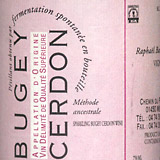|
Bugey Cerdon
Continuing our pre-holiday inquiry into alternative sparkling wines, let's wrap up the work week with a quick look at a particularly offbeat model, a sweet and fizzy pink bubbly from the Jura mountains near Savoie in Eastern France.
But Bugey Cerdon isn't just for sultry July afternoons any more: I submit that its crisp, tart-sweet profile, loaded with the juicy strawberry aromas and flavors of the Gamay grape, makes it an unexpectedly fine choice for the Thanksgiving table. It marries well with both light turkey meat and dark (not to mention all the traditional trimmings), and its Champagne-style bottle and cork pop with the festive flair that adds fun to the holiday meal. Today's tasting, a Bugey Cerdon made by Raphaël Bartucci, is a blend of 80% Gamay and 15% Poulsard, an indigenous regional grape, with a spash of 5% Chardonnay to lighten the color and heighten the flavor. It's labeled "methode ancestrale" (loosely, "historic method," the same ancient process that I mentioned in Monday's report on Blanquette de Limoux), with the further explanation "Pétillant obtenu par fermentation spontanée en bouteille" ("Sparkling obtained by spontaneous fermentation in the bottle"). Curiously, although the methode ancestrale is truly ancient in Limoux, dating back to 1531, it's a much more recent arrival in Bugey, where wine makers in the 1940s and '50s started gassing the local still wines with carbon dioxide - much like soft-drink production - to make them fizz. A few artisanal producers around the village of Cerdon later adopted the "ancestral method," putting partially fermented wine in Champagne-style bottles to develop natural carbonation while retaining some sweetness; this process was formally recognized with legal approval for the "Bugey Cerdon" label as recently as 1962. Bartucci Bugey Cerdon is a fully organic wine in the vineyard and the winery, and adds no sulfites beyond those naturally produced by fermentation. Accordingly, it should be drunk as young as possible, not cellared.
Published in 1994 to worldwide acclaim, the first edition of Jancis Robinson's seminal volume immediately attained legendary status, winning every major wine book award including the Julia Child/IACP and James Beard awards, as well as writer and woman of the year accolades for its editor on both sides of the Atlantic. Combining meticulously-researched fact with refreshing opinion and wit, the Companion offers almost 4,000 entries on every wine-related topic imaginable. Now exhaustively updated throughout, this third edition incorporates the very latest international research and presents over 400 new entries. Illustrated with maps of every important wine region in the world, useful charts and diagrams, and stunning color photography, this Companion is unlike any other wine book, offering an understanding of wine in its many wider contexts - notably historical, cultural, geographic, and scientific - and serving as a truly companionable point of reference into which any wine lover can dip, browse, and linger.
The Champagne-style cork comes out of this clear, bright pink wine with a fully carbonated pop, and it pours with a frothy fizz that quickly falls back to a lasting bubble stream. Its lovely scent blends fresh strawberries, rising bread dough and subtle earthiness. Fizzy and crisp, it's well off-dry, but good acidity keeps it from cloying, juicy strawberry flavors hanging on in a long finish. Light and gulpable at just 8% alcohol, it's ideal for summer sipping, but I wouldn't turn it down on a holiday table. U.S. importer: USA Wine Imports, NYC; Jenny & François Selections, World Wide Wine Ltd. (Nov. 16, 2006) FOOD MATCH: Anticipating a Thanksgiving dinner combination, it went well with roasted turkey thighs. The crisp strawberry fruit and crisp acidity made a fine flavor match with the earthy, slightly oily flavor of turkey dark meat, and the sweetness of the wine seemed to dry out a bit with the food match. VALUE: Certainly worth the $20 toll, at least on occasion, if only to add a rather rare and offbeat wine and region to your collection. WHEN TO DRINK: Needs to be drunk up promptly, certainly within a year. Since it's non-vintage and bears no "best-by" date, you should buy from a trusted vendor and avoid dusty bottles. This isn't usually a problem, though, as this limited-production wine generally moves off the shelf fast.
PRONUNCIATION:
WEB LINK:
FIND THIS WINE ONLINE:
TALK ABOUT WINE ONLINE:
Today's article is cross-posted in our Netscape WineLovers Community, where we also welcome comments and questions. To contact me by E-mail, write wine@wineloverspage.com. I'll respond personally to the extent that time and volume permit.
PRINT OUT TODAY'S ARTICLE Administrivia To subscribe or unsubscribe from The 30 Second Wine Advisor, change your E-mail address, or for any other administrative matters, please use the individualized hotlink found at the end of your E-mail edition. If this is not practical, contact me by E-mail at wine@wineloverspage.com, including the exact E-mail address that you used when you subscribed, so I can find your record. We do not use our E-mail list for any other purpose and will never give or sell your name or E-mail address to anyone. I welcome feedback, suggestions, and ideas for future columns. To contact me, please send E-mail to wine@wineloverspage.com All the wine-tasting reports posted here are consumer-oriented. In order to maintain objectivity and avoid conflicts of interest, I purchase all the wines I rate at my own expense in retail stores and accept no samples, gifts or other gratuities from the wine industry.
Friday, Nov. 17, 2006
|


 Raphaël Bartucci NV Bugey Cerdon ($19.99)
Raphaël Bartucci NV Bugey Cerdon ($19.99)



